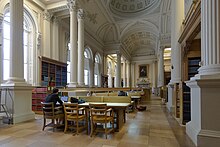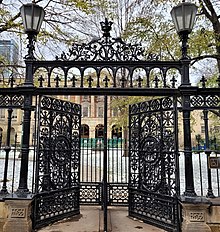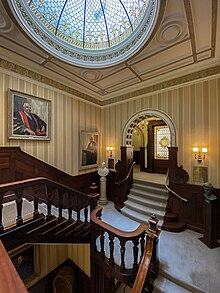Osgoode Hall
| Osgoode Hall | |
|---|---|
Office building and courthouse | |
| Architectural style | Palladian, Neoclassical |
| Address | 130 Queen Street West |
| Town or city | Toronto, Ontario |
| Country | Canada |
| Coordinates | 43°39′08″N 79°23′08″W / 43.65222°N 79.38556°W |
| Current tenants | |
| Named for | William Osgoode |
| Construction started | 1829 |
| Completed | 1832 |
| Owner | |
| Technical details | |
| Floor count | 3 |
| Grounds | 6 acres (2.4 ha) |
| Design and construction | |
| Architect(s) | John Ewart and William Warren Baldwin |
| Designated | 1979 |
| Designated | 1990 |
Osgoode Hall is a landmark building in
It originally served to house the regulatory body for lawyers in Ontario along with its law school, formally established as Osgoode Hall Law School in 1889, which was the only recognized professional law school for the province at the time.[3] The original building was constructed between 1829 and 1832 in the late Georgian Palladian and Neoclassical styles. It currently houses the Ontario Court of Appeal, the Divisional Court of the Superior Court of Justice, the offices of the Law Society of Ontario and the Great Library of the Law Society.
History

The 6-acre (2.4 ha) site at the corner of Lot Street (
Between
From 1855 to 1857, the building was refurbished and enlarged again, according to a design by the firm Cumberland and Storm, to accommodate courts with the original 1829 building becoming the east wing. From 1880 to 1891, the building was again expanded twice in order to accommodate its law school.
The building was designated a National Historic Site of Canada in 1979,[5][6] and by the City of Toronto under the Ontario Heritage Act in 1990.[7]
Design



Despite the expansions, the hall presents a unified design in the late Palladian style. The iron fence surrounding the lawns of Osgoode Hall has become a landmark in itself. Its distinctive iron gates are narrow and restrictive; it is a long-standing myth that they were designed to keep livestock out of the grounds of the hall. Despite this, an incident in the 1950s occurred in which students unsuccessfully attempted to pass a cow through one of the gates.[8] The gates were likely due to Victorian architectural fashion, rather than wandering cattle.[9][10]
Two
-
Sculpture inside the hall
-
Osgoode Hall Dining Room
-
Hall Rooms
-
Hall lobby
-
Level 2 Courtroom
-
American Room
See also
Notes
- ^ "Courageous settlers first located in Carleton back in 1818". Ottawa Citizen. Apr 28, 1953. pp. A20. Retrieved 2 December 2015.
- ^ http://www.heritagefdn.on.ca/userfiles/HTML/nts_1_6190_1.html Ontario Heritage Trust Osgoode Hall
- ^ "History".
- ^ a b c William Renwick Ridell, "Osgoode Hall", Report of the Annual Meeting, Canadian Historical Association, Vol. 1, No. 1, 1922.
- ^ Osgoode Hall. Directory of Federal Heritage Designations. Parks Canada. Retrieved 22 August 2012.
- ^ Osgoode Hall. Canadian Register of Historic Places. Retrieved 22 August 2012.
- ^ 130 Queen Street West, Toronto Inventory of Heritage Properties
- ^ The Execution. Osgoode Hall Turns 175 - Documenting a Landmark. Archives of Ontario. Retrieved 2019-01-29.
- ^ Osgoode Hall. Lost Rivers. Retrieved 2008-03-06.
- ^ Law, Susan. "Osgoode Hall Fence". Osgoode Hall (website). (Accessed 21 June 2007).
External links
- Osgoode Hall Turns 175 - Documenting a Landmark Web exhibit at the Archives of Ontario
- Susan Law's personal Osgoode Hall main site
- Audio Tours of Osgoode Hall from the Law Society of Upper Canada website.
- Visual Tour of Osgoode Hall from the Law Society of Upper Canada website.
- Osgoode Hall National Historic Site of Canada. Canadian Register of Historic Places.
- Information on Osgoode Hall tours and other heritage programs on the Discover Ontario Museums website.






